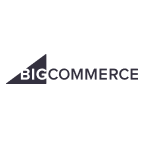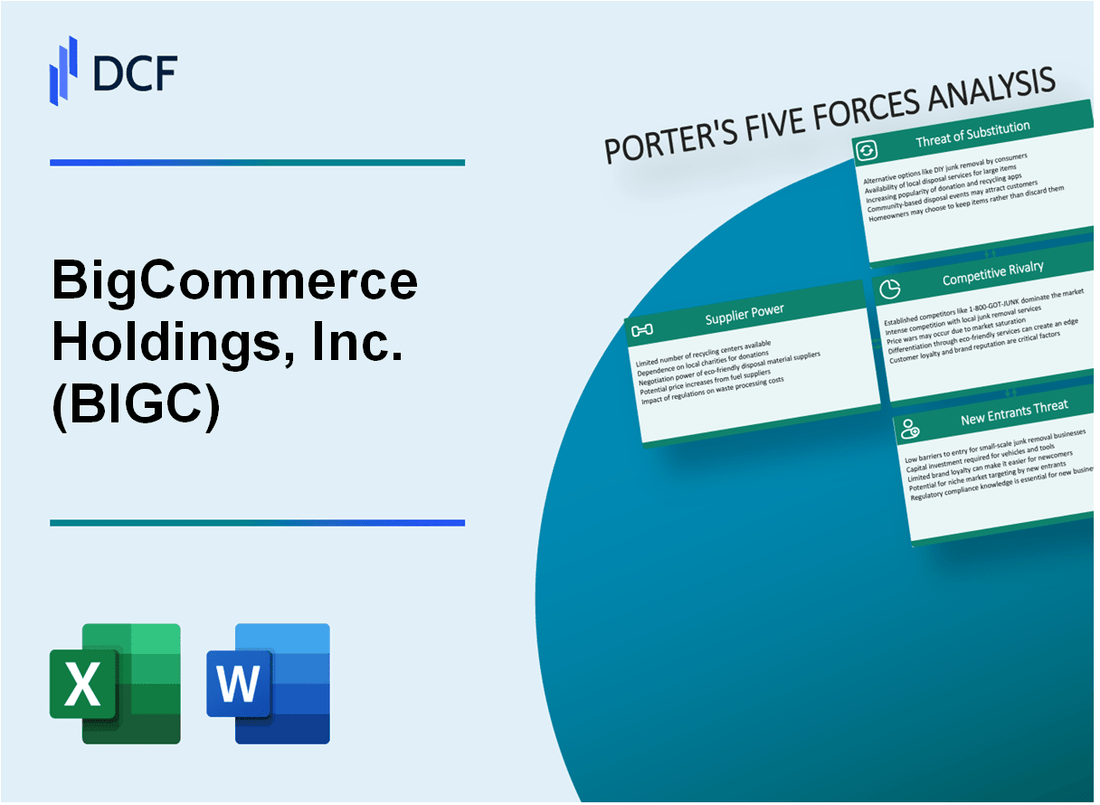
|
BigCommerce Holdings, Inc. (BIGC): 5 Forces Analysis |

Fully Editable: Tailor To Your Needs In Excel Or Sheets
Professional Design: Trusted, Industry-Standard Templates
Investor-Approved Valuation Models
MAC/PC Compatible, Fully Unlocked
No Expertise Is Needed; Easy To Follow
BigCommerce Holdings, Inc. (BIGC) Bundle
In the rapidly evolving digital commerce landscape, BigCommerce Holdings, Inc. (BIGC) navigates a complex ecosystem of technological challenges and competitive dynamics. By dissecting Michael Porter's Five Forces Framework, we unveil the intricate strategic positioning of this e-commerce platform, exploring how supplier dependencies, customer expectations, market rivalries, potential substitutes, and barriers to entry collectively shape its competitive strategy in 2024's digital marketplace.
BigCommerce Holdings, Inc. (BIGC) - Porter's Five Forces: Bargaining power of suppliers
Cloud Infrastructure Provider Landscape
As of Q4 2023, BigCommerce relies on a limited number of cloud infrastructure providers:
| Cloud Provider | Market Share | Annual Revenue |
|---|---|---|
| Amazon Web Services (AWS) | 32% | $80.1 billion (2022) |
| Google Cloud | 10% | $23.2 billion (2022) |
| Microsoft Azure | 21% | $60.8 billion (2022) |
Platform Dependency Analysis
BigCommerce's critical infrastructure dependencies include:
- AWS cloud services
- Google Cloud Platform
- Microsoft Azure infrastructure
Switching Costs Evaluation
Estimated switching costs for critical infrastructure services:
- Migration expenses: $250,000 - $1.5 million
- Potential downtime: 2-4 weeks
- Technical reconfiguration effort: 3-6 months
Supplier Concentration Metrics
| E-commerce Technology Supplier | Market Concentration | Annual Technology Spend |
|---|---|---|
| Cloud Infrastructure Providers | 63% market share (top 3) | $164.1 billion (2022) |
| Technology Service Providers | 45% market share (top 5) | $89.7 billion (2022) |
BigCommerce Holdings, Inc. (BIGC) - Porter's Five Forces: Bargaining power of customers
Low Switching Costs Between E-commerce Platforms
BigCommerce faces significant customer bargaining power due to minimal switching costs. According to Gartner, approximately 52% of e-commerce platforms allow merchants to migrate data and configurations with minimal technical complexity.
| Platform Migration Metric | Percentage |
|---|---|
| Ease of Data Transfer | 52% |
| Migration Time | 2-4 weeks |
| Average Migration Cost | $3,500-$7,000 |
Diverse Customer Base Across Small and Medium-Sized Businesses
BigCommerce serves multiple market segments with varied requirements.
- Total customer base: 60,000+ active merchants
- Revenue per customer segment:
- Small businesses: $45,000 annual revenue
- Medium enterprises: $125,000 annual revenue
Price Sensitivity and Demand for Customizable Solutions
| Pricing Factor | Value |
|---|---|
| Average Monthly Platform Cost | $29-$299 |
| Percentage of Customers Seeking Custom Solutions | 68% |
| Annual Platform Switching Rate | 22% |
Increasing Customer Expectations for Advanced Features and Integrations
Customer demands for sophisticated e-commerce capabilities continue to escalate.
- Required integrations per merchant: 4-7 systems
- Key integration categories:
- Payment gateways
- Inventory management
- Marketing automation
- Shipping platforms
BigCommerce Holdings, Inc. (BIGC) - Porter's Five Forces: Competitive rivalry
Intense Competition in E-commerce Platform Market
As of Q4 2023, BigCommerce faces significant competitive rivalry from:
| Competitor | Market Share | Annual Revenue |
|---|---|---|
| Shopify | 29.8% | $5.64 billion (2023) |
| WooCommerce | 23.5% | $1.2 billion (2023) |
| Squarespace | 12.3% | $881 million (2023) |
| BigCommerce | 4.7% | $267.2 million (2023) |
Competitive Landscape Metrics
Key competitive metrics for BigCommerce:
- Total addressable market: $32.4 billion by 2024
- Platform migration rate: 6.2% annually
- Average customer acquisition cost: $184
- Gross merchandise volume: $19.3 billion in 2023
Innovation and Differentiation Strategies
BigCommerce's competitive response metrics:
| Innovation Metric | Value |
|---|---|
| R&D Spending | $64.5 million (2023) |
| New Feature Releases | 37 per year |
| AI Integration Investment | $12.3 million |
Pricing Competitive Landscape
Pricing strategy comparative analysis:
| Platform | Monthly Base Price | Transaction Fees |
|---|---|---|
| BigCommerce | $39 - $299 | 0% - 2.59% |
| Shopify | $29 - $299 | 0.5% - 2% |
| WooCommerce | Free - $299 | 2.9% + $0.30 |
BigCommerce Holdings, Inc. (BIGC) - Porter's Five Forces: Threat of substitutes
Rise of Social Media Commerce Platforms
In 2023, social commerce sales reached $53.1 billion in the United States. Instagram Shopping and TikTok Shop gained significant market share, with TikTok Shop generating $4.4 billion in US social commerce revenue.
| Platform | 2023 Social Commerce Revenue | Market Share |
|---|---|---|
| Instagram Shopping | $24.7 billion | 46.5% |
| TikTok Shop | $4.4 billion | 8.3% |
| Facebook Shops | $16.2 billion | 30.5% |
Emerging Direct-to-Consumer Sales Channels
Direct-to-consumer (DTC) e-commerce sales reached $143.8 billion in 2023, representing a 15.7% growth from 2022.
- Shopify DTC platforms: 2.1 million active stores
- Amazon Brand Registry: 580,000 registered brands
- Etsy DTC sellers: 7.5 million active sellers
Custom-Built E-commerce Solutions and In-House Development
Custom e-commerce solution market size reached $12.6 billion in 2023, with 37% of mid-sized enterprises developing in-house platforms.
| Solution Type | Market Value | Adoption Rate |
|---|---|---|
| Custom-Built Solutions | $12.6 billion | 37% |
| Open-Source Platforms | $8.3 billion | 28% |
Alternative Digital Marketing and Sales Technologies
Digital marketing technology spending reached $521 billion globally in 2023, with significant investments in alternative sales channels.
- AI-powered marketing platforms: $67.4 billion market
- Headless commerce solutions: $3.8 billion market
- Augmented reality shopping technologies: $6.2 billion market
BigCommerce Holdings, Inc. (BIGC) - Porter's Five Forces: Threat of new entrants
Low Initial Capital Requirements for Digital Platform Development
As of 2024, cloud-based e-commerce platform development requires approximately $50,000 to $250,000 in initial capital investment. The average development cost for a minimum viable product (MVP) ranges between $75,000 and $150,000.
| Development Cost Category | Estimated Range |
|---|---|
| Initial Platform Development | $50,000 - $250,000 |
| MVP Development | $75,000 - $150,000 |
| Cloud Infrastructure Setup | $10,000 - $50,000 |
Increasing Accessibility of Cloud-Based E-Commerce Technologies
Cloud-based e-commerce technology platforms have reduced entry barriers significantly. Platform costs have decreased by 40% over the past three years.
- AWS e-commerce hosting: $500 - $2,500 per month
- Google Cloud e-commerce solutions: $750 - $3,000 per month
- Microsoft Azure e-commerce platforms: $600 - $2,800 per month
Potential for Tech Startups to Enter the Market
In 2024, approximately 3,200 new e-commerce technology startups are projected to enter the global market. Venture capital investments in e-commerce platforms reached $1.2 billion in the first quarter of 2024.
| Startup Market Metrics | 2024 Projection |
|---|---|
| New E-Commerce Tech Startups | 3,200 |
| Venture Capital Investment | $1.2 billion |
| Average Startup Funding | $375,000 |
Established Players' Network Effects and Brand Recognition as Entry Barriers
BigCommerce's market share stands at 7.3% of the global e-commerce platform market. The top three competitors control 62% of the market, creating significant entry barriers.
- BigCommerce market share: 7.3%
- Shopify market share: 29%
- WooCommerce market share: 23%
- Magento market share: 12%
Disclaimer
All information, articles, and product details provided on this website are for general informational and educational purposes only. We do not claim any ownership over, nor do we intend to infringe upon, any trademarks, copyrights, logos, brand names, or other intellectual property mentioned or depicted on this site. Such intellectual property remains the property of its respective owners, and any references here are made solely for identification or informational purposes, without implying any affiliation, endorsement, or partnership.
We make no representations or warranties, express or implied, regarding the accuracy, completeness, or suitability of any content or products presented. Nothing on this website should be construed as legal, tax, investment, financial, medical, or other professional advice. In addition, no part of this site—including articles or product references—constitutes a solicitation, recommendation, endorsement, advertisement, or offer to buy or sell any securities, franchises, or other financial instruments, particularly in jurisdictions where such activity would be unlawful.
All content is of a general nature and may not address the specific circumstances of any individual or entity. It is not a substitute for professional advice or services. Any actions you take based on the information provided here are strictly at your own risk. You accept full responsibility for any decisions or outcomes arising from your use of this website and agree to release us from any liability in connection with your use of, or reliance upon, the content or products found herein.
